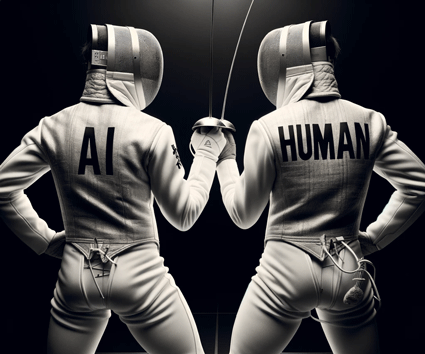Dueling intelligences
How realistic is the idea that flesh and blood actors will soon find themselves performing alongside long-dead movie stars?
By Brad Berens
Recently, I shared a microfiction (1,000 words or less), a short science fiction story called “The Only Living Boy,” about an actor, Tom, who is the only flesh and blood performer in a production of Shakespeare’s Othello. The rest of the actors are dead celebrities that Generative AIs have brought back to synthetic life and who perform in Augmented Reality—projected onto the stage where Tom acts.

Image created by DALL-E
This time, I’ll dig into how realistic the story world is or isn’t. You don’t have to read “The Only Living Boy” (although it ain’t bad) to understand this week’s piece, but fair warning: Ahoy! Thar Be Spoilers Ahead!
Let’s dig in.
Synthetic actors are reality today, not science fiction. AI-created virtual influencers abound, and companies like Synthesia can create a virtual spokesperson in 10 minutes.
It’s not just virtual people who have never lived. If you’ve ever seen the term “deep fake,” it refers to faked video and images that bad actors use to trick us into believing lies. There can also be deep fakes of real people: if that jerk friend of yours sends you a video of a demure movie star engaged in shockingly extreme porn, it’s a deep fake.
Not all digital duplicates of real people are malicious. In China, virtual clones of real livestream shopping influencers take over when the human originals need to sleep. According to MIT Technology Review, “With just a few minutes of sample video and $1,000, brands never have to stop selling their products.”
Back in 2016’s Rogue One (a Star Wars movie), a virtual young Carrie Fisher was unconvincing: it plowed right into the uncanny valley at high speed. In 2020 with The Rise of Skywalker, the filmmakers went to extraordinary lengths to bring back Princess Leia in a not-creepy way (because Fisher had died in 2016).
The technology is getting better. This summer’s Indiana Jones and the Dial of Destiny showed a digitally de-aged Harrison Ford who was so convincing that I kept forgetting Ford is now 81.
The rise of Generative AI over the last year or so is democratizing access to virtual people that can be disturbingly realistic. Here’s an illustrative passage from a recent New Yorker article about Nvidia (the company that makes the chips for most Generative AI programs):
The specialist then showed me “Diane,” a hyper-realistic digital avatar that speaks five languages. A powerful generative A.I. had studied millions of videos of people to create a composite entity. It was the imperfections that were most affecting—Diane had blackheads on her nose and trace hairs on her upper lip. The only clue that Diane wasn’t truly human was an uncanny shimmer in the whites of her eyes. “We’re working on that,” the specialist said.
Resurrecting dead celebrities is already possible: the technical challenges are less complicated than getting the rights from the families or estates and aggregating video and audio recordings (voice cloning can use as little as three seconds of a sample). After that, the resurrectors just need computational power and time.
We’re not at the stage where “there’s an app for that” to bring Judy Garland and Mickey Rooney back to life for a new Andy Hardy movie on an iPhone, but we’re closer than you think.
The least realistic aspect of “The Only Living Boy”—in the term—is that Tom, a flesh and blood actor, is able to act with resurrected and projected versions of Paul Robeson, Ingrid Bergman, Philip Seymour Hoffman, Carrie Fisher, and more.
First, as anybody who has ever groaned “not another Zoom!” already knows, there’s a chasm between being with other people virtually and being with other people in meat space (a.k.a. real life). Although actors are by definition great pretenders, the absence of other flesh and blood bodies onstage will inhibit the chemistry that makes live performance different. (Elsewhere, I’ve talked about this as “eventness.”)
There’s more: at present, human intelligences and artificial intelligences don’t mix well in real-time and space.
For example, I drive a Tesla Model 3 (I bought it before Elon Musk went bananas) and shelled out $10,000 for the full self-driving package called Autopilot (a big mistake). When the car drives itself, it feels different than when a human drives. Nothing about the way the car evaluates its surroundings, speeds up, slows down, stops, and changes lanes is natural.
Back when we did a big Future of Transportation Project here at the Center, My friend and colleague Jeffrey Cole speculated that someday humans wouldn’t be allowed to drive in most situations: car aficionados would go to specific places to drive the way people go to specific places to ride horses today.
Synthetic actors are reality today, not science fiction. AI-created virtual influencers abound, and companies like Synthesia can create a virtual spokesperson in 10 minutes. . .In China, virtual clones of real livestream shopping influencers take over when the human originals need to sleep. According to MIT Technology Review, “With just a few minutes of sample video and $1,000, brands never have to stop selling their products.”
Despite a few decades of Star Trek stories about people falling in love with holograms, I’m confident that—again, in the short term—while virtual actors will all perform splendidly together, the combination of flesh and blood actors and virtual actors will have an awkwardness similar to version when AIs drive.
Other Implications?
I’ve limited this piece to how realistic/unrealistic “The Only Living Boy” is on a technological level, but I’m alive to the negative social implications (outside what we’re already seeing with deep fakes).
How, for example, will young actors get work if it’s cheap and easy to resurrect virtual versions of dead actors who are already famous?
I suspect that we’ll see something similar to what happened with the resolution of the Hollywood Writers Strike: employment opportunities for writers are better, but because those opportunities improved there will be fewer writing employment opportunities overall.
In the future, ambitious actors won’t just be competing with their flesh and blood peer group: they’ll be competing with every actor who ever lived, and a bunch of entirely virtual actors who never lived.
Like the old “Made in the U.S.A.” signs, in the future we’ll see “Made by Humans” signs on all sorts of products and services. My fond hope is that we’ll vote with our dollars and our attention for artisanal culture.
Wouldn’t that be nice?
__________

Brad Berens is the Center’s strategic advisor and a senior research fellow. He is principal at Big Digital Idea Consulting. You can learn more about Brad at www.bradberens.com, follow him on Post and/or LinkedIn, and subscribe to his weekly newsletter (only some of his columns are syndicated here).
See all columns from the Center.
December 20, 2023

